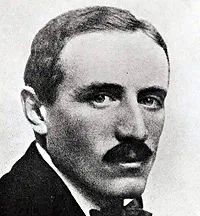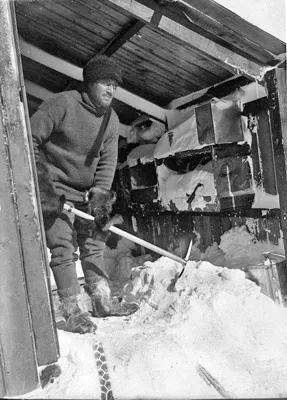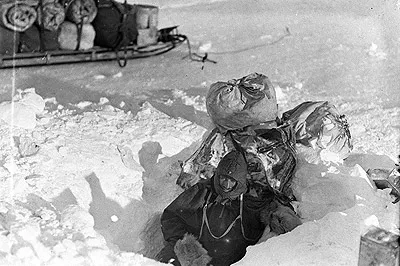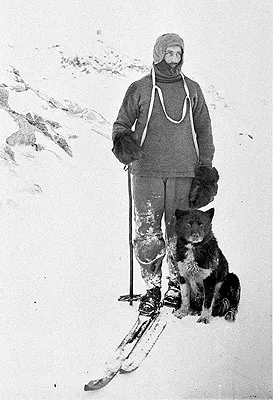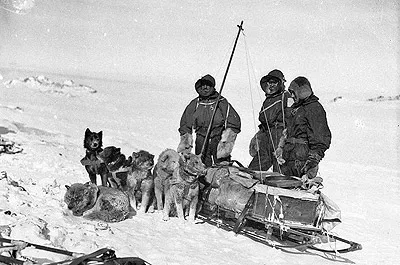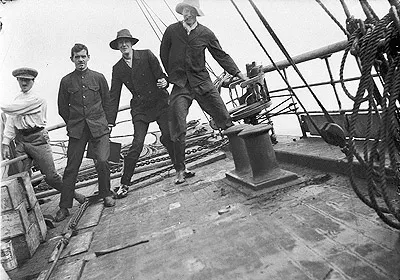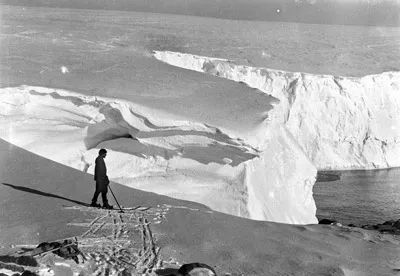Dr. Xavier Mertz, 1882-1913
Biographical notes
In charge of Greenland dogs - Aurora 1911-1913
6th October 1882 - 8th January 1913
Single, of Basle, Switzerland, a graduate in Law of the Universities
of Leipzig and Berne. Prior to joining the Expedition he had
gained the Ski-running Championship of Switzerland and was an
experienced mountaineer. At the Main Base (Adelie Land) he was
assisted by B. E. S. Ninnis in the care of the Greenland dogs.
On January 7, 1913, during a sledging journey, he lost his life,
one hundred miles south-east of Winter Quarters.
From
Appendix 1, Mawson - Heart of the Antarctic
Xavier Mertz was part of a three man party with Douglas Mawson and Belgrave Ninnis who in the summer of 1912/13 made up the "Far Eastern Party" using dog teams to travel quickly to the east of the expedition base. Disaster struck on the 14th of December 1912 when Ninnis broke through the snow roof of a large crevasse with the largest sledge, strongest dog team and much of the food including all the dog food.
Mawson and Mertz immediately turned back to the base and used the remaining six dogs to supplement their own diet. It is thought that by eating the dogs Mertz became poisoned by the very high levels of vitamin A found in the livers. Both men became ill though Mertz deteriorated rapidly becoming delirious in the evening of the 7th of January, he was found dead in his sleeping bag by Mawson the next morning.
References to Mertz in Mawson's book "The Home of the Blizzard" buy USA buy UK
- Before the ship had reached Queen's Wharf, the berth
generously provided by the Harbour Board, the Greenland dogs
were transferred to the quarantine ground, and with them
went Dr. Mertz and Lieutenant Ninnis, who gave up all their
time during the stay in Hobart to the care of those
important animals.
- For several days in succession, about the middle of
February, the otherwise continuous wind fell off to a calm
for several hours in the evening. On those occasions Mertz
gave us some fine exhibitions of skiing, of which art he was
a consummate master. Skis had been provided for every one,
in case we should have to traverse a country where the snow
lay soft and deep. From the outset, there was little chance
of that being the case in wind-scoured Adelie Land.
Nevertheless, most of the men seized the few opportunities
we had to become more practiced in their use. My final
opinion, however, was that if we had all been experts like
Mertz, we could have used them with advantage from time to
time.
- August 1 was marked by a hurricane, and the celebration
in the evening of Swiss Confederation Day. Mertz was the
hero of the occasion as well as cook and master of
ceremonies. From a mysterious box he produced all kinds of
quaint conserves, and the menu soared to unknown delicacies
like "Potage a la Suisse, Choucroute garnie aux saucission
de Berne, Puree de foie gras trufee, and Leckerley de Bale."
Hanging above the buoyant assembly were the Cross of
Helvetia and the Jack of Britannia.
- As the plans for the execution of such a journey had of
necessity to be more provisional than in the case of the
others, I determined to undertake it, accompanied by Ninnis
and Mertz, both of whom had so ably acquitted themselves
throughout the Expedition and, moreover, had always been in
charge of the dogs.
- Mertz was well in advance of us when I noticed him hold
up his ski-stick and then go on. This was a signal for
something unusual so, as I approached the vicinity, I looked
out for crevasses or some other explanation of his action.
As a matter of fact crevasses were not expected, since we
were on a smooth surface of neve well to the southward of
the broken coastal slopes. On reaching the spot where
Mertz
had signalled and seeing no sign of any irregularity, I
jumped on to the sledge, got out the book of tables and
commenced to figure out the latitude observation taken on
that day. Glancing at the ground a moment after, I noticed
the faint indication of a crevasse. It was but one of many
hundred similar ones we had crossed and had no specially
dangerous appearance, but still I turned quickly round,
called out a warning word to Ninnis and then dismissed it
from my thoughts.
Ninnis, who was walking along by the side of his sledge, close behind my own, heard the warning, for in my backward glance I noticed that he immediately swung the leading dogs so as to cross the crevasse squarely instead of diagonally as I had done. I then went on with my work.
There was no sound from behind except a faint, plaintive whine from one of the dogs which I imagined was in reply to a touch from Ninnis's whip. I remember addressing myself to George, the laziest dog in my own team, saying, "You will be getting a little of that, too, George, if you are not careful."
When I next looked back, it was in response to the anxious gaze of Mertz who had turned round and halted in his tracks. Behind me, nothing met the eye but my own sledge tracks running back in the distance. Where were Ninnis and his sledge? - At 9 P.M. we stood by the side of the crevasse and I
read the burial service. Then Mertz
shook me by the hand with a short "Thank you!" and we
turned away to harness up the dogs.
- At 2 A.M. on the 17th we had only covered eleven
miles when we stopped to camp. Then Mertz
shot and cut up Johnson while I prepared the supper.
- January 1, 1913.- Outside, an overcast sky and
falling snow. Mertz was not up to his
usual form and we decided not to attempt blundering
along in the bad light, believing that the rest would be
advantageous to him.
- January 4.- The sun was shining and we had intended
rising at 10 A.M., but Mertz was not
well and thought that the rest would be good for him.
- Mertz appeared to be depressed and,
after the short meal, sank back into his bag without
saying much. Occasionally, during the day, I would ask
him how he felt, or we would return to the old subject
of food. It was agreed that on our arrival on board the
'Aurora' Mertz was to make penguin
omelettes, for we had never forgotten the excellence of
those we had eaten just before leaving the Hut.
- The skin was peeling off our bodies and a very poor
substitute remained which burst readily and rubbed raw
in many places. One day, I remember, Mertz
ejaculated, "Just a moment," and, reaching over, lifted
from my ear a perfect skin-cast. I was able to do the
same for him. As we never took off our clothes, the
peelings of hair and skin from our bodies worked down
into our under-trousers and socks, and regular
clearances were made.
- It was a sad blow to me to find that Mertz
was in a weak state and required helping in and out of
his bag. He needed rest for a few hours at least before
he could think of travelling.
- Late on the evening of the 8th I took the body of Mertz, wrapped up in his sleeping-bag, outside the tent, piled snow blocks around it and raised a rough cross made of the two half-runners of the sledge.
Landmarks named after Xavier Mertz
Feature Name:
Mertz Glacier
Feature Type: glacier
Latitude:
67°30'S
Longitude: 144°45'E
Description: A heavily crevassed
glacier, about 45 mi long and averaging 20 mi wide. It reaches
the sea between Cape De la Motte and Cape Hurley where it continues
as a large glacier tongue. Discovered by the AAE (1911-14) under
Douglas Mawson.
Feature Name:
Mertz Glacier Tongue
Feature Type: glacier
Latitude: 67°10'S
Longitude:
145°30'E
Description: A
glacier tongue, about 45 mi long and 25 mi wide, forming the
seaward extension of Mertz Glacier. Discovered and named by
the AAE (1911-14) under Douglas Mawson.
Feature Name: Mertz-Ninnis
Valley
Feature Type: valley
Latitude: 67°25'S
Longitude:
146°00'E
Description: An
undersea valley named in association with the Mertz Glacier/Mertz
Tongue and the Ninnis Glacier/Ninnis Tongue. Name approved 12/71
(ACUF 132).
Variant Names: Adelie
Depression / Mertz-Ninnis Trough
Biographical information
- I am concentrating on the Polar experiences of the men involved.
Any further information or pictures visitors may have will be gratefully received.
Please email
- Paul Ward, webmaster.
What are the chances that my ancestor was an unsung part of the Heroic Age
of Antarctic Exploration?

